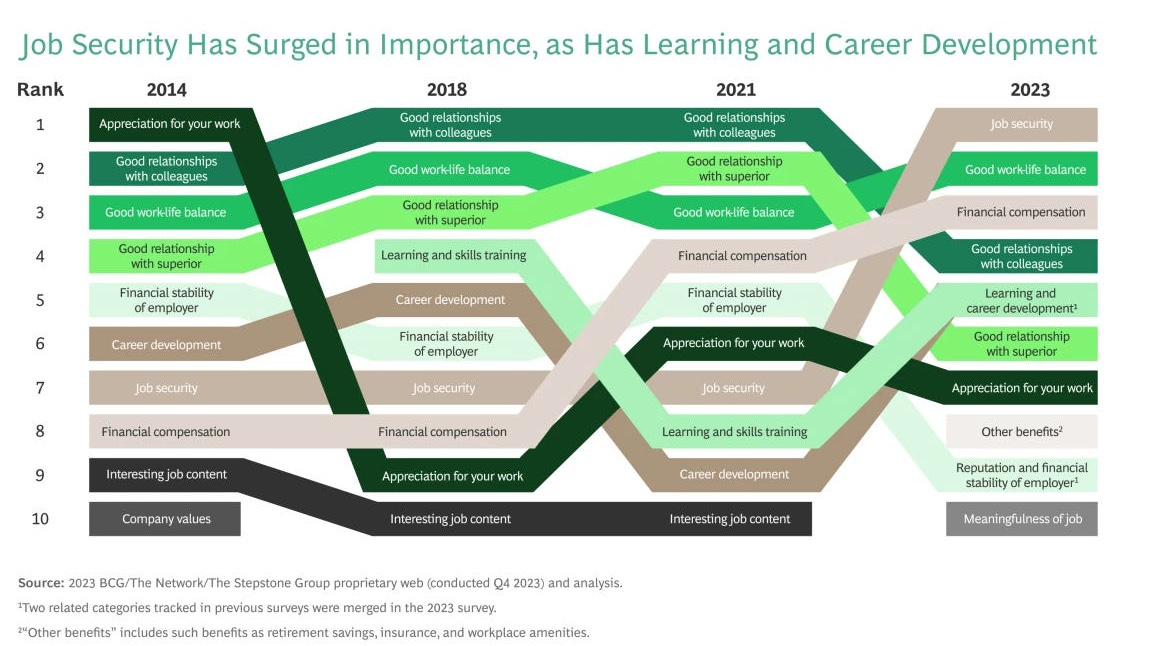The Return of Stable Jobs & The Departure of Phones From Schools
Also: how the loudest voices on social media skew reality
Trends & Topics
Trend: Quiet Quitting is Out, Stability is In
BCG Talent and Skills Report & Wall Street Journal
White collar Gen Z workers are sticking with their jobs 18% longer than millennials did in their first seven years in the workforce. A recent article from the WSJ declares that “20-Somethings learn to love their corporate jobs.” I’m not sure I would say love but there is definitely a renewed focus on the benefits of stability.
People can only take so much risk and the world feels riskier than ever right now. The explosive growth of artificial intelligence, social unrest, geopolitical realignments, and a very weird election cycle are all contributing to an overall sense of unease. So it makes sense that stability serves as a strong retention tool.
BCG has measured priorities of young workers since 2014. “Good colleagues” and “feeling appreciated” were the top priorities every year, except 2023. In 2023, the top priority for the first time was “job security.”
One aspect absent from the conversation is how cultures at stable jobs have changed. Many stable jobs were once considered boring, bureaucratic, and soul-sucking. Those jobs still exist, but overall things have improved. The pandemic ushered in more hybrid roles, more flexibility, and cultural improvements.
Topic: Do phones belong in schools?
The Carolina Journal & The Labour Economics Journal
The phone-based childhood is coming to an end. Florida, Indiana, Louisiana, and South Carolina have implemented statewide bans or restrictions that limit student cell phone use during class. Other states are leaving regulation up to districts. Across the pond, the United Kingdom is banning phone use in every school.
One study out of England’s largest cities found that when schools banned phones there was “significant improvement in scores on high-stakes tests. Low-performing students especially benefited, with double the increase in scores as other students. But high-achieving students also saw a big boost, getting the equivalent of an extra hour of learning per week and evidence of improved focus.”
Besides test scores, I am hearing anecdotally from teachers in phone-banned schools that students are chattier, more engaged, and less distracted.
Earlier this month, I participated in a conversation about phone bans at school with government officials and I am still having a hard time understanding the pro-phones side of this argument. If you get it, please let me know directly or in the comments section.
Topic: How does social media distort reality?
ScienceDirect, Claire E. Robertson, Karen S. Del Rosario, Jay Von Bavel
(I found this through the podcast, Re:Thinking Podcast with Adam Grant)
Social media content seems particularly off the rails right now so it’s comforting to know that this is not a refection of reality. A new paper shows that social media is dominated by a small number of extremely vocal users, whose opinions and content are disproportionally amplified.
To the surprise of no one, the paper finds that "negative, hostile, and polarizing content tends to be more widely shared and amplified online, creating a false impression that such behavior is more prevalent than it is in the real world.”
For example:
1% of communities launch 74% of conflict
0.1% of users spread 80% of fake news
3% of active accounts are toxic, but they produce 33% of all content
Norms change based on our assumption that social media reflects what large groups of people actually believe. So even if we intellectually understand that the online world does not represent the real world, our perceptions of norms shift (and have already shifted) because we forget this disconnect. When we see constant hostile online content, we do assume that we live in a particularly hostile culture.
Exposure to extreme content can normalize unhealthy and dangerous behavior. An example from the paper states that “teens exposed to extreme content related to alcohol consumption thought dangerous alcohol consumption was normative.” Polarization, intergroup hostility, and support for authoritarian regimes are also linked to distorted norm perceptions.
The amount of time that we spend online has grown since the pandemic, particularly for young people. I’m hopeful that this paper and emerging data can help people understand what can happen when we unconsciously conflate the online and offline world.
Work
I took a much longer break than I anticipated from this newsletter, so thank you all for sticking around. I’m moving to a bi-monthly cadence for the rest of the year.
This summer was spent doing year 4 research interviews with my 2020 college cohort, kicking off a research fellowship, and speeding into a very busy fall speaking season.
Also my kids got lice. So that gets us up to speed.
This fall I’m speaking/spoke in Tulum, Milwaukee, Kansas City, Hershey, Seattle, Boston, Atlanta, New York, Minneapolis, Toronto, Miami, Louisville, and San Diego.
I was back on the Making the Ideal Real podcast with Ryan Goulart where we dove into the generational trends shaping the future.
On November 20th, I’m hosting a panel with young adults (18-29) in San Diego. We’ll mostly be discussing trust and money. I’ll report back next month key findings from the panel.
/Misc.
The trailer for A Complete Unknown has arrived.
Timothee Chalamet playing Bob Dylan is like a dream. I still remember the first time I heard my mom play “Don’t Think Twice, It’s All Right” on the guitar. It remains the perfect song.


